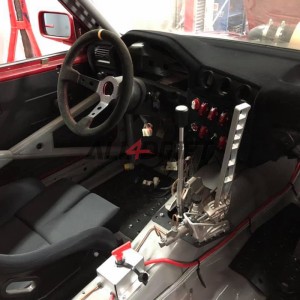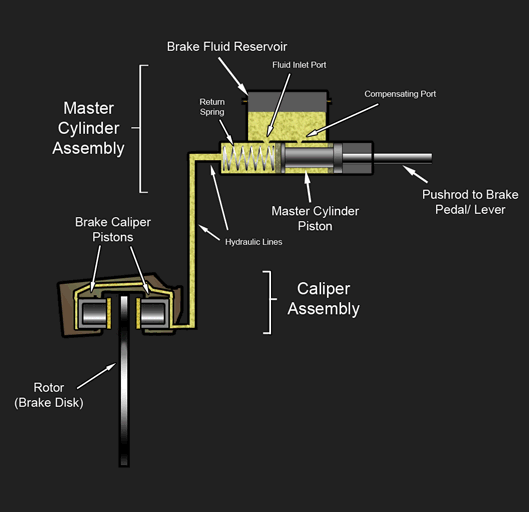Possibilities of connecting a hydraulic handbrake
Added: 3.9.2019 18:19.15 Views count: 11636
03 September 2019
Many of you are solving the question of what the ideal connection of the hydraulic handbrake will be. I will try to answer this question for you.

- First, let's briefly discuss what hydraulic handbrakes are primarily used for.
- We'll talk about why they're not installed in production vehicles by default.
- We'll break down the connection options, including the ones currently most commonly used in the world of motorsport.
Most production vehicles have a handbrake operated by a cable, which tightens the handbrake pads, and they are pushed back in the opposite direction when released by springs. The stock handbrake also has a locking system that simply keeps it in a locked position for safe parking. These characteristics are the reason why hydraulic handbrakes are not commonly used in cars straight off the assembly line. Specifically, it's because it's not as easy to keep the hydraulic brake in a position that blocks the wheels for an extended period, such as overnight parking. Additionally, the installation and components of a hydraulic handbrake are considerably more complicated compared to a cable setup, increasing the cost of the system.
But why do many vehicles used in amateur and professional levels of motorsport utilize hydraulic handbrakes?
Unlike the stock cable handbrake, locking the wheels with a hydraulic handbrake is much more effective in the short term, and since it's used without the possibility of prolonged locking – this feature also becomes an advantage in case of immediate unlocking needs, as the locking system is bypassed, preventing unintended locking.
What are the connection options for integrating a handbrake into a conventional vehicle that originally had a cable handbrake?
We've divided it into 3 most well-known connection forms described briefly below:
1) Integration of the handbrake INTO the vehicle's circuit
- Probably the most common and widely used integration of a hydraulic handbrake.
The circuit leading to the rear brakes is interrupted and connected to the input of the hydraulic handbrake. The circuit is then closed back towards the rear brakes from the hydraulic handbrake.

When braking with the foot pedal, the brake fluid passes through the brake cylinder of the hydraulic handbrake, also braking the rear wheels. In the case of engaging the handbrake, the cylinder is closed back, creating pressure only towards the rear brakes. Unfortunately, this often pressurizes the rest of the brake system, resulting in a hard and insensitive brake pedal for possible braking.

In another scenario, when braking with the pedal and wanting to lock the rear wheels with the handbrake, we will also observe that the handbrake is relatively stiff and its function is somewhat unpredictable.
A significant problem with this system is the complicated intermediate section in the brake circuit (the brake cylinder of the hydraulic handbrake), bleeding the system, and achieving its proper functionality. Often, achieving perfect bleeding is nearly impossible, resulting in various forms of handbrake malfunction. A significant advantage is the relative simplicity of implementing such a connection, even in domestic conditions, and the cost, where we don't need so many additional parts and components for functionality. Usually, it involves a few connectors and several meters of ideally steel or easily malleable copper tubing. Alternatively, a more expensive option is armored hoses.
Advantages:
- Price
- Simplicity of basic connection
- Ease of part availability
Disadvantages:
- Complicated bleeding process
- Insufficient sensitivity of the brake pedal when using the handbrake and vice versa
- Increased risk of brake system leakage
- In case of malfunction, the entire brake system may become inoperative
2) Integration using additional brakes
-This integration has become a privilege of even more amateur vehicles lately. So far, it has been more for professionals and cars with a larger budget. Why is that? Simply put, all the disadvantages of the previous integration become a thing of the past. Only one disadvantage is added, and that's the price. In short, I'll try to describe the principle of integration and its functionality.
By using a suitable adapter, the number of brakes on the axle is duplicated, and the hydraulic handbrake is directly connected to them (to the added brakes) with its own cylinder or with a cylinder stored externally anywhere in the vehicle. Nowadays, adapters exist for many vehicles, and they can be attached to the vehicle by welding or screwing them into the wheel hubs. Often, a skilled mechanic can, through adaptation, preserve ABS functionality, which is not so simple because the material is in collision with the ABS system sensor due to the strength of the adapter.

The most significant, or rather the most significant disadvantage mentioned earlier, is the cost of construction, where in addition to the hydraulic handbrake with a cylinder and reservoir, we also need an adapter for connecting additional brakes and additional brakes, which must be equipped with hoses and brake pads.
Advantages:
- Preservation of brake system functionality
- Easy bleeding of the circuit for the hydraulic handbrake
- 100% functionality of the hydraulic handbrake
- Trouble-free operation when using and combining systems
Disadvantages:
- Price
- Component complexity
- More complex component integration
3) Splitting the stock brake circuit (front/rear)
- As the name suggests, the original circuit is split, where the front part is closed off, and only the front axle reacts to pedal pressure, and the rear part of the circuit is connected to the hydraulic handbrake, usually also with an external reservoir. It's a rather non-standard solution, which, of course, has a huge disadvantage. In a classic attempt to slow down using the pedal, the rear wheels simply don't engage.

I wouldn't recommend this integration because it seems quite dangerous in case of needing to stop the vehicle in a risky situation. Failure can occur. As for the functionality of the handbrake, it will be at the level of solution number 2 literally because the hydraulic handbrake will have its own circuit and its own brakes.
Advantages:
- Simplicity of solution
- Easy bleeding of the circuit for the hydraulic handbrake
- 100% functionality of the hydraulic handbrake
- Price
Disadvantages:
- EXTREMELY disrupted brake system functionality
- There are a few special systems where the cylinder plays a major role, allowing ABS integration and maintaining braking properties when using both the foot brake and hydraulic handbrake. Unfortunately, I've only heard about this system and have never had personal experience with it. I assume an unacceptably high price, and therefore it's only used in top-level motorsports in factory teams, where the budget knows no bounds.




